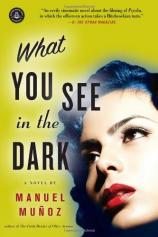Reading Group Guide
Discussion Questions
What You See in the Dark

1. Many books begin with an epigraph that sets a particular tone or introduces a theme. What does the epigraph by the poet Ai suggest to you about the novel’s larger concerns?
2. Most novels typically begin with first- or third-person narration. What You See in the Dark is mostly narrated in third person, but it begins in second person with a “you” who is later revealed to be Candy, Teresa’s coworker at the shoe store. Why do you think the novel opened and closed with this point of view? What might have been different about the novel if it had opened or closed with third-person narration?
3. Why do you suppose the author referred to Janet Leigh and Alfred Hitchcock as “the Actress” and “the Director,” rather than using their real names? Are there other instances in the novel in which people are addressed or referred to using pronouns rather than just their names?
4. Chapters 3 and 4 both begin with the same construction: “Around town, she was known as.” What might this construction be saying about recurrences in the novel? Are there other moments when events or phrases are echoed? Do they have anything in common?
5. Though readers already know what has happened to Teresa, chapter 4 details how she met Dan and how she made a choice to pursue him over her more loyal and persistent suitor, Cheno. Discuss why you think the novel delayed this introduction and what effect it had on the characterization of Teresa.
6. In the diner scene in chapter 5, the Actress touches the hand of Carter, the driver, who returns the gesture with a “light, downward feather of a touch, just once” (page 99) before bringing up his wife in conversation. What do you think is happening in this scene? Is the Actress just testing out her new role? Or is there an attraction between them?
7. Why do you think Teresa steals the boots from the storeroom?
8. Part 2 begins with Dan’s rush to leave town. Arlene is the central figure in that chapter, and she often thinks about her ex-husband Frederick and her long-lost brother. In the course of so much intense drama surrounding Dan’s getaway, why does the chapter bring up those other two men so often? Discuss what this does to shape the character of Arlene.
9. The famous Psycho shower scene is broken down, frame by frame, to close out part 2. How different is the effect on the page than on the screen? Why do you think the author chose this particular moment for the Actress’s last appearance in the novel?
10. “Things change, but she wasn’t ever going to” (page 214). Describe Arlene’s epiphany at the close of this novel. Is she really the central figure? Does she stand in as a parallel for Mrs. Bates in the film Psycho, or is she an entirely different character?
11. Chapter 11 is the only one with a man at the center: it’s Alfred Hitchcock returning from the Cannes Film Festival, and the film described is Frenzy. Discuss why the novel waits until then to showcase the Director. Why is the Director so troubled by the fact that he has been unable to produce a work comparable to Psycho?
12. Candy ends up marrying Cal, which also means she will no longer be privy to the gossip traded at the shoe store. Discuss why the novel features Candy so vividly imagining the murder of Teresa. Is Candy obsessed with the murder? What is the novel saying about our willingness and desire to witness such horrific scenes of violence? Is it a satisfying ending in this regard?
What You See in the Dark
- Publication Date: March 13, 2012
- Paperback: 288 pages
- Publisher: Algonquin Books
- ISBN-10: 1616201401
- ISBN-13: 9781616201401







